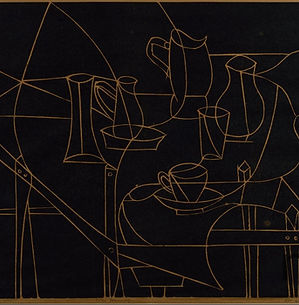Bansi Parimu
Modern
There is scant information available on Bansi Parimu, or Parimoo as some publications list him. However, we came across two of his paintings in the collection of National Gallery of Modern Art in Delhi. Therefore, we felt we must dig deeper and find out about this modern artist from India, whose work have been preserved at the national gallery, so here goes.
Bansi Parimu, a self-taught artist, was born in Srinagar in 1933. As with other Kashmiri artists, growing up amidst the natural beauty of the valley, his early forays into art were through landscapes. His love of the natural extended beyond art, and he was also an avid horticulturalist, as well as an activist to preserve natural resources: he wrote extensively on the rising pollution in Kashmir since the 1970’s. In 1984, he protested the construction of a concrete bridge over the Jhelum, even threatening to self-immolate if the plan proceeded further! The insurgency in the late 1980s created a lot of unrest in the valley, yet he refused to leave his home until the very last moment. A man of deep convictions and emotions, the relocation to Delhi in 1990 was very hard on him. It left him in an emotional and mental turmoil, a state which took a toll on his health and lead to his untimely death in 1991.
Today his contributions as an artist and activist may have receded in the background. We haven’t come across galleries featuring his works, but artists and critics remember him fondly and credit him with keeping the art scene in Jammu and Kashmir alive and vibrant, in 1962, he founded and managed the Young Artists Club, to encourage likeminded artists; additionally, he was also the founder member of the Kashmir Art Society. He initiated annual artists camps in Srinagar, so that artists from the valley could interact with those from other parts of the country.
Though he began by painting landscapes in an academic style, he soon evolved his art into a quasi-abstract style, which was expressionist in its manifestation. We say expressionist as the works were driven by passion - and his need to express the anguish he experienced, his helplessness at his loss of home.
He exhibited the same passion in his works. We see vibrant colours, strong lines, a boldness of statement. Being a writer and a poet, the titles of his works give the viewer a clue to engage in the works meaningfully.
Bansi Parimu also participated in the Progressive Artists Association founded by Tiloke Kaul, S N Butt and P N Kachru in 1952. He held his first solo exhibition in Ambala in 1954, then in New Delhi in 1959. Dhoomimal Gallery in Delhi represented the artists’ works regularly; he also exhibited in Mumbai in 1963, and in Ahmedabad in 1966. Bansi Parimoo was also an avid photographer. His works are in the collection of the National Gallery of Modern Art, and many other private collections in the country and across the globe.
Bansi Parimoo passed away in 1991




